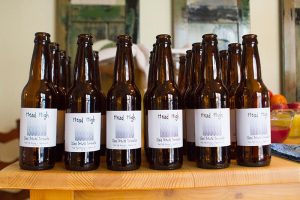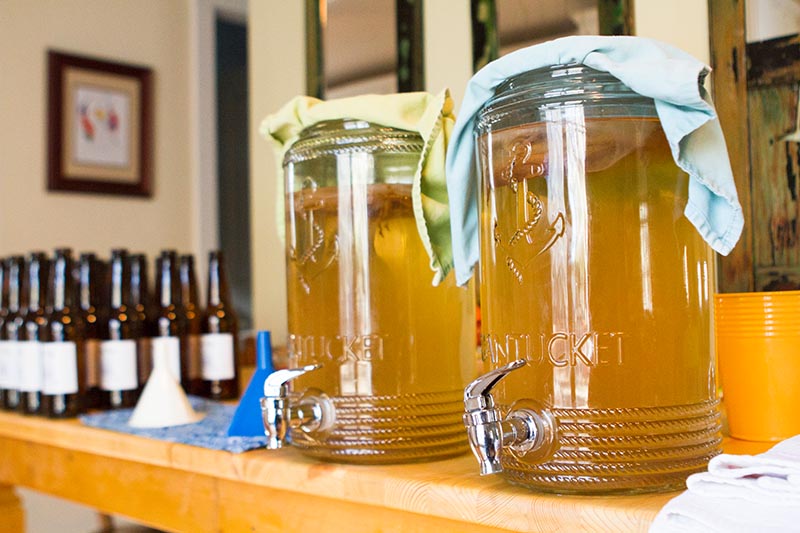In cabinets and pantries across the country, there is a creature growing — a jellyfish-like colony that sits suspended in a vat, slowly eating sugar, releasing gases, and transforming a simple jug of sugared tea into an effervescent and slightly vinegary drink.
What is this creature? It is a symbiotic colony of bacteria and yeast, more commonly known as a SCOBY or a “mother,” which is used to brew kombucha.
Meet SCOBY
Kombucha has been brewed for centuries, with the earliest recorded usage in Manchuria around 220 BCE. It is made by fermenting a SCOBY for seven to 10 days in sweetened tea and then bottling it, which allows for a secondary fermentation to take place. The resulting beverage is slightly carbonated, and packed with live cultures that have a myriad of health benefits.
Kombucha is said to aid digestion, cleanse the gut, detoxify the body, help with sleep and weight loss, stimulate the immune system, improve liver function, and prevent disease. The drink is high in acid and contains B vitamins, antioxidants, and a trace amount of alcohol (a natural byproduct of fermentation).
Meet the M.V. brewers
Kombucha brewing has enjoyed a rise in popularity over the past few years. There are a handful of companies that distribute nationally, such as GT’s Kombucha and KeVita, which is owned by Pepsi. However, the craft still remains largely an underground, homebrew practice, and, like many a handmade art, craft, or science, it has found a home here on Martha’s Vineyard.
“There are a lot of people here on the Island that dabble in it,” Emma Young, a home brewer in West Tisbury, said. “So many people here know about it, and have made it at different times or do make it.”
Emma has been brewing for about a year, since she received a green tea kombucha SCOBY from a friend in Oregon and a black tea kombucha SCOBY from a friend in upstate New York. She wasn’t a regular drinker until she started brewing herself, but now she drinks it every day in lieu of a cup of coffee, which has helped cut down on her caffeine intake.
Jan Buhrman, owner of Kitchen Porch catering, learned how to ferment from a friend, like many brewers, and has been doing it ever since. She teaches brewing classes where people are guided step by step through the brewing process, and leave with their first batch, which will continue to produce kombucha if maintained properly.
For Becky Bonds, learning how to make kombucha was both a lifesaver and a life giver. After quitting her job and experiencing a few harrowing months of unemployment last year, Becky took a fermentation class at the Oak Bluffs library. Since then, she has been experimenting with kombucha brewing, and in October 2016, she launched Head High Kombucha, which is the first business of its kind on Martha’s Vineyard. Becky is in the process of getting approved to sell her product at the farmers markets this season.
“I think drinking and brewing kombucha is a generational thing,” Becky Bonds said. “That being said, there are a lot of brewers that are not in my generation. It was initially a homebrew movement. I think kombucha has a big underground community. I’ve been contacted by people that I’ve never met before to get kombucha.”
Fermentation fundamentals
Teaching the art of kombucha is less scientific than you would imagine. The basic steps are to procure a SCOBY, keep it in a sterilized glass container of sweet tea with a cloth over the top for a few days, and then place the liquid into airtight bottles or jars, which are left to ferment for another few days. If you’re feeling adventurous, you can add fruit or vegetable juice or purées between the first and second fermentation.
The SCOBY you use, type of tea, amount of sugar, time spent in first and second fermentation, and additives are adjustable variables that vastly change the final product.
When she went to her first fermentation class, Becky remembers leaving with a list of general guidelines about brewing that were more frustrating than helpful. “I was initially put off by the vagueness of the class. Looking back, though, if you were to come into my kitchen today, I would say the same thing,” she said.
“I got my cultures from friends, and they taught me how, so I’ve been able to pass that on to new friends and teach them about it,” Emma said. “The way I learned to do it was listening to how my friends did it, and then I tried it for the first time. Then it makes more sense.” She said it was easier to get a feel for her own taste preferences and how her particular SCOBY was reacting to her recipe and timing, and to develop it from there.

The process of getting batches right is not always pleasant — or clean. “There was the time I lost a batch to fruit fly infestation; I cried,” Becky said. She and her husband Marc Lavergne, who helps with brewing and bottling, are accustomed to occasional explosions in their kitchen when a particularly carbonated batch explodes, or when a newly opened bottle sprays tea everywhere.
Becky has four “mothers” producing kombucha at the moment, which allows her to make more bottles a week than she can consume.
“I have no reason to produce 300 bottles of kombucha a week,” Becky said. “We had no room in our fridge, so I’m pretty much just giving it away at this point. It’s good to be my friend right now.”
Becky has a hard time throwing out her mothers’ “babies” — a SCOBY replica that is produced after each fermentation — and prefers to find loving homes for them when she can. For some brewers, rather than throw out the SCOBY babies, they give them to friends who are interested in learning about fermentation, and the circle of underground fermentation continues.
“I know and respect my SCOBYs very well,” Emma said. “But I have no problem composting the new SCOBYs. I’m fine with being brutal. I know it’s a living, growing creature, so I recognize that, but I don’t let them own me.”
To drink or not to drink?
There have been many studies on the health benefits of kombucha, but there is still a fair amount of debate between doctors and dedicated tea drinkers about the validity of the claims. Dedicated tea drinkers swear by its miraculous healing powers, but some doctors are wary of endorsing it as a panacea. Ask enough of the fans, though, and you’ll hear a chorus of testimonials.
“I think of kombucha as a real treat,” Jan said in an email. “It’s a biochemical powerhouse. I see it as life. Fermentation makes foods more nutritious. Fermented foods are microscopic living organisms, which means loaded nutrients. The process creates beneficial enzymes, B vitamins, omega-3 fatty acids, and various strains of probiotics.”
“I’ve been hearing for years from my mom and others that probiotics and yogurt are good for you, but once I started drinking kombucha, it became really apparent,” Emma said. “It’s like a secret weapon, and you think, ‘I need to do this every day.’ It gives you energy. Now that this is part of my practice, I usually have a little bit in the afternoon after lunch, and it re-energizes me until the evening.”
“I’ve just found something that I really like to make and I really enjoy drinking,” Becky said. “I believe in being healthy, and I just want to spread the word. I think a byproduct of it is I am going to be leading the way for the brewers who might pop up here on the Island, but for me it’s just about doing what I like and sharing it with people.”
For people looking to remove soda or coffee from their diet, kombucha can be a great replacement.
“In American culture, kombucha is definitely connected to the health craze, but it’s something that kids can drink,” Emma said. “It’s a great replacement for sweet drinks. I think it is something that could be more approachable, but the fact that it’s [made from] a big jellyfish-looking weird mushroom — it’s not for everybody.”
Procuring the goods
If you’re feeling inspired to start brewing your own kombucha, SCOBYs and fermenting kits are available for purchase online. It is also possible to grow a SCOBY from a bottle of kombucha that still has the remnants of the mother inside. Or if you know a brewer through the grapevine, ask them for a SCOBY. They won’t mind getting one off their hands.
“We have our regular [drinkers], we have the curious, and we have some who find kombucha downright disgusting,” Jan said. “That is why I believe it is so important to keep making it and selling it. We have become fearful about bacteria, and our health has paid a price for it. Without bacteria, we have no life.”
For more information on kombucha brewing classes, or to contact Jan Burhman, call 508-645-5000 or visit kitchenporch.com. Look for her kombucha at the farmers markets on Wednesdays and Thursdays during the summer season.
For more information about Head High Kombucha, email Becky Bonds at beckybonds@gmail.com. Look for her kombucha in the farmers markets this summer.




